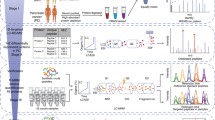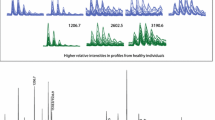Abstract
Background
The proteome varies with physiologic and disease states. Few studies have been reported that differentiate the proteome of those with pancreatic cancer.
Aim
To apply proteomic-based technologies to body fluids. To differentiate pancreatic neoplasia from nonneoplastic pancreatic disease.
Methods
Samples from 50 patients (15 healthy (H), 24 cancer (Ca), 11 chronic pancreatitis (CP)) were prospectively collected and underwent analysis. A high-throughput method, using high-affinity solid lipophilic extraction resins, enriched low molecular weight proteins for extraction with a high-speed 200-Hz matrix-assisted laser desorption/ionization time-of-flight mass spectrometer (MALDI-MS; Bruker Ultraflex III). Samples underwent software processing with FlexAnalysis, Clinprot, MatLab, and Statistica (baseline, align, and normalize spectra). Nonparametric pairwise statistics, multidimensional scaling, hierarchical analysis, and leave-one-out cross validation completed the analysis. Sensitivity (sn) and specificity (sp) of group comparisons were determined. Two top-down-directed protein identification approaches were combined with MALDI-MS and tandem mass spectrometry to fully characterize the most significant protein biomarker.
Results
Using eight serum features, we differentiated Ca from H (sn 88%, sp 93%), Ca from CP (sn 88%, sp 30%), and Ca from both H and CP combined (sn 88%, sp 66%). In addition, nine features obtained from urine differentiated Ca from both H and CP combined with high efficiency (sn 90%, sp 90%). Interestingly, the plasma samples (considered by the Human Proteome Organization to be the preferred biological fluid) did not show significant differences. Multidimensional scaling indicated that markers from both serum and urine led to a highly effective clinical indicator of each specific disease state.
Conclusions
The proteomic analysis of noninvasively acquired biological fluids provided a high level of predictability for diagnosing pancreatic cancer. While the proteomic analysis of serum was capable of screening individuals for pancreatic disease (i.e., CP and Ca vs. H), specific urine biomarkers further distinguished malignancy (Ca) from chronic inflammation (CP).





Similar content being viewed by others
References
Lam YW, Mobley JA, Evans JE, Carmody JF, Ho SM. Mass profiling-directed isolation and identification of a stage-specific serologic protein biomarker of advanced prostate cancer. Proteomics 2005;5:2927–2938. doi:10.1002/pmic.200401165.
Mobley JA, Lam YW, Lau KM, Pais VM, L'Esperance JO, Steadman B et al. Monitoring the serological proteome: the latest modality in prostate cancer detection. J Urol 2004;172:331–337. doi:10.1097/01.ju.0000132355.97888.50.
Petricoin EF, Ardekani AM, Hitt BA, Levine PJ, Fusaro VA, Steinberg SM et al. Use of proteomic patterns in serum to identify ovarian cancer. Lancet 2002;359:572–577. doi:10.1016/S0140-6736(02)07746-2.
Li J, Zhang Z, Rosenzweig J, Wang YY, Chan DW. Proteomics and bioinformatics approaches for identification of serum biomarkers to detect breast cancer. Clin Chem 2002;48:1296–304.
Won Y, Song HJ, Kang TW, Kim JJ, Han BD, Lee SW. Pattern analysis of serum proteome distinguishes renal cell carcinoma from other urologic diseases and healthy persons. Proteomics 2003;3:2310–2316. doi:10.1002/pmic.200300590.
Jemal A, Siegel R, Ward E, Hao Y, Xu J, Murray T et al. Cancer statistics, 2008. CA Cancer J Clin 2008;58:71–96.
Christein JD, Kendrick ML, Iqbal CW, Nagorney DM, Farnell MB. Distal pancreatectomy for resectable adenocarcinoma of the body and tail of the pancreas. J Gastrointest Surg 2005;9:922–927. doi:10.1016/j.gassur.2005.04.008.
Sperti C, Pasquali C, Piccoli A, Pedrazzoli S. Survival after resection for ductal adenocarcinoma of the pancreas. Br J Surg 1996;83:625–631. doi:10.1002/bjs.1800830512.
Yeo CJ, Cameron JL, Sohn TA, Lillemoe KD, Pitt HA, Talamini MA, Hruban RH, Ord SE, Sauter PK, Coleman J, Zahurak ML, Grochow LB, Abrams RA. Six hundred fifty consecutive pancreaticoduodenectomies in the 1990s: pathology, complications, and outcomes. Ann Surg 1997;226:248–257. discussion 257–260.
Hauskrecht M, Pelikan R, Malehorn DE, Bigbee WL, Lotze MT, Zeh HJ et al. Feature selection for classification of SELDI-TOF-MS proteomic profiles. Appl Bioinformatics 2005;4:227–246. doi:10.2165/00822942-200504040-00003.
Rosty C, Goggins M. Identification of differentially expressed proteins in pancreatic cancer using a global proteomic approach. Methods Mol Med. 2005;103:189–197.
Yu Y, Chen S, Wang LS, Chen WL, Guo WJ, Yan H et al. Prediction of pancreatic cancer by serum biomarkers using surface-enhanced laser desorption/ionization-based decision tree classification. Oncology 2005;68:79–86. doi:10.1159/000084824.
Jin Y, Manabe T. Direct targeting of human plasma for matrix-assisted laser desorption/ionization and analysis of plasma proteins by time of flight-mass spectrometry. Electrophoresis 2005;26:2823–2834. doi:10.1002/elps.200410421.
Bower H, Shulman R, Herbert P, Ronan R, Wehrly K. The complete amino acid sequence of alanine apolipoprotein (apoC-3), and apolipoprotein from human plasma very low density lipoproteins. J Biol Chem 1974;249:4975–4984.
Roghani A, Zannis VI. Mutagenesis of the glycosylation site of human ApoCIII. O-linked glycosylation is not required for ApoCIII secretion and lipid binding. J Biol Chem 1988;263:17925–17932.
Chen J, Anderson M, Misek DE, Simeone DM, Lubman DM. Characterization of apolipoprotein and apolipoprotein precursors in pancreatic cancer serum samples via two-dimensional liquid chromatography and mass spectrometry. J Chromatogr A 2007;1162:117–125. doi:10.1016/j.chroma.2007.03.096.
Acknowledgements
The John W. Kirklin Foundation Research and Education Fellowship Award, 2007, University of Alabama at Birmingham Department of Surgery.
Author information
Authors and Affiliations
Corresponding author
Additional information
Presented at Digestive Disease Week, Society for Surgery of the Alimentary Tract, May 20, 2008, San Diego, California.
Rights and permissions
About this article
Cite this article
Kojima, K., Asmellash, S., Klug, C.A. et al. Applying Proteomic-Based Biomarker Tools for the Accurate Diagnosis of Pancreatic Cancer. J Gastrointest Surg 12, 1683–1690 (2008). https://doi.org/10.1007/s11605-008-0632-6
Received:
Accepted:
Published:
Issue Date:
DOI: https://doi.org/10.1007/s11605-008-0632-6




